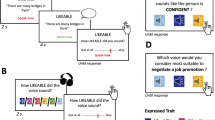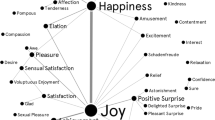Abstract
To investigate factors that affect the mutual entrainment of vocal activity rhythms, female general psychology students paired according to attitude similarity questionnaires engaged in 40-minute introductory conversations. Fourier analyses performed on speakers' on-off vocal activity demonstrated periodic oscillations in talkativeness. Although some dyads coordinated their vocal activity rhythms, speech accommodation was not predicted by attitude similarity or attraction and did not affect ratings of conversation quality. These rhythms of dialogue appear resistant to change, their behavioral momentum rooted perhaps in an underlying chronobiology.
Similar content being viewed by others
Reference
Aronsson, K., Jonsson, L., & Linell, P. (1987). The courtroom hearing as middle ground: Speech accommodation by lawyers and defendants. Journal of Language and Social Psychology, 6, 99-116.
Bales, R. F. (1950). Interaction process analysis. Cambridge, MA: Addison-Wesley.
Bochner, A. P. (1984). The functions of human communicating in interpersonal bonding. In C. Arnold & J. Bowers (Eds.), Handbook of rhetorical and communication theory (pp. 544-621). Boston, MA: Allyn & Bacon.
Box, G. E. P., & Jenkins, G. M. (1970). Time series analysis: Forecasting and control. San Francisco, CA: Jossey-Bass.
Byrne, D. (1961). Interpersonal attraction and attitude similarity. Journal of Abnormal and Social Psychology, 62, 713-715.
Byrne, D. (1971). The attraction paradigm. New York, NY: Academic Press.
Byrne, D., & Clore, G. L. (1966). Predicting interpersonal attraction toward strangers presented in three different stimulus modes. Psychonomic Science, 4, 239-240.
Byrne, D., & Clore, G. L. (1970). A reinforcement model of evaluative responses. Personality: An International Journal, 1, 103-128.
Cappella, J. N., & Palmer, M. T. (1990). Attitude similarity, relational history and attraction: The mediating effects of kinesic and vocal behaviors. Communication Monographs, 57, 161-183.
Cappella, J. N., & Palnap, S. (1981). Talk and silence sequences in informal conversations III: Interspeaker influence. Human Communication Research, 7, 117-132.
Chapple, E. D. (1970). Culture and biological man: Explorations in behavioral anthropology. New York, NY: Holt, Rinehart & Winston.
Chapple, E. D. (1982). Movement and sound: The musical language of body rhythms in interaction. In M. Davis (Ed.), Interactional rhythms (pp. 31-52). New York, NY: Human Sciences Press, Inc.
Condon, W. S., & Ogston, W. D. (1967). A segmentation of behavior. Journal of Psychiatric Research, 5, 221-235.
Dabbs, J. M. (1983). Fourier analysis of the rhythm of conversation.(ERIC Document Reproduction Service No. ED 222 959). Paper presented at The Annual Meeting of The American Psychological Association (Washington DC, August 23-27, 1982).
Duck, S. W. (1976). Interpersonal communication in developing acquaintance. In G. R. Biller (Ed.), Explorations in interpersonal communication. Beverly Hills, CA: Sage.
Giles, H. (1973). Accent mobility: A model and some data. Anthropological Linguistics, 15, 87-105.
Giles, H., Coupland, N., & Coupland, J. (1991). Accommodation theory: Communication, context, and consequence. In H. Giles, N. Coupland, & J. Coupland (Eds.), Contexts of Accommodation: Developments in Applied Sociolinguistics (pp. 1-68). Cambridge: Cambridge University Press.
Gottman, J. M. (1979). Marital Interaction: Experimental Investigations. San Diego, CA: Academic Press.
Hale, J. L., & Burgoon, J. K. (1984). Models of reactions to changes in nonverbal immediacy. Journal of Nonverbal Behavior, 8, 287-314.
Hayes, D. P., & Cobb, L. (1970). Ultradian rhythms in social interaction. In A. W. Siegman & S. Feldstein (Eds.), Of Speech and Time: Temporal Speech Rhythms in Interpersonal Contexts. Hillsdale, NJ: Erlbaum.
Jaffe, J., Beebe, B., Feldstein, S., Crown, C. L., & Jasnow, M. D. (2001). Rhythms of dialogue in infancy. Monographs for the Society for Research in Child Development No. 265, Vol. 66(2), vi-131.
Jaffe, J., & Feldstein, S. (1970). Rhythms of dialogue. New York, NY: Academic.
Gottman, J. M. (1981). Time-series analysis: A comprehensive introduction for social scientists. Cambridge: Cambridge University Press.
Kimberly, R. P. (1970). Patterns in human interaction. Nature, 228, 88-90.
Matarazzo, J. D., Weins, A. N., Matarazzo, R. G., & Saslow, G. (1968). Speech and silence behavior in clinical psychotherapy and its laboratory correlates. In J. Schlier, H. Hunt, J. D. Matarazzo, & C. Savage (Eds.). Research in psychotherapy (pp. 347-394). Washington, DC: American Psychological Association.
Mauer, R. E., & Tindall, J. H. (1983). Effects of postural congruence on client's perceptions of counselor empathy. Journal of Counseling Psychology, 30, 158-163.
Natale, M. (1975). Convergence of mean vocal intensity in dyadic communications as a function of social desirability. Journal of Personality and Social Psychology, 32, 790-804.
Nevin, J. A., & Grace, R. C. (2000). Behavioral momentum and the law of effect. Behavioral and Brain Sciences, 23, 73-130.
Newcomb, T. M. (1956). The prediction of interpersonal attraction. Psychological Review, 60, 393-404.
Newcomb, T. M. (1961). The acquaintance process. New York, NY: Holt, Rinehart, and Winston.
Pearson, K., & Lee, A. (1903). On the laws of inheritance in man. I. Inheritance of physical characters. Biometrika, 2, 357-462.
Russell, R. J. L. (1985). Significance tables for the results of Fast Fourier transforms. British Journal of Mathematical and Statistical Psychology, 38, 116-119.
Street, R. L., Jr. (1983). Noncontent speech convergence in adult-child interactions. In R. N. Bostrom (Ed.), Communication yearbook, Vol. 7 (pp. 369-395). Beverly Hills, CA: Sage.
Warner, R. M. (1979). Periodic rhythms in conversational speech. Language and Speech, 22, 381-389.
Warner, R. M. (1992a). Dimensions of social interaction tempo: A factor analytic study of time and frequency domain indexes of interaction structure. Journal of Psycholinguistic Research, 21, 173-191.
Warner, R. M. (1992b). Sequential analysis of social interaction: Assessing internal versus social determinants of behavior. Journal of Personality and Social Psychology, 63, 51-60.
Warner, R. M. (1992c). Cyclicity of vocal activity increases during conversation: Support for a nonlinear systems model of dyadic social interaction. Behavioral Science, 37, 128-138.
Warner, R. M., Kenny, D. A., & Stoto, M. (1979). A new round robin analysis of variance for social interaction data. Journal of Personality and Social Psychology, 37, 1742-1757.
Warner, R. M., Malloy, D., Schneider, K., Knoth, R., & Wilder, B. (1987). Rhythmic organization of social interaction and observer ratings of positive affect and involvement. Journal of Nonverbal Behavior, 11, 57-74.
Warner, R. M., & Mooney, K. (1988). Individual differences in vocal activity rhythm: Fourier analysis of cyclicity in amount of talk. Journal of Psycholinguistic Research, 17, 99-111.
Warner, R. M., Waggener, T. B., & Kronauer, R. E. (1983). Synchronized cycles in ventilation and vocal activity during spontaneous conversational speech. Journal of Applied Physiology: Respiratory, Environmental and Exercise Physiology, 54, 1324-1334.
Welkowitz, J., & Feldstein, S. (1969). Dyadic interaction and induced differences in perceived similarity. Proceedings of the 77th Annual Convention of the American Psychological Association, 4, 343-344.
Welkowitz, J., Feldstein, S., Finkelstein, M., & Aylesworth, L. (1972). Changes in vocal intensity as a function of interspeaker influence. Perceptual and Motor Skills, 35, 715-718.
Wever, R. A. (1979). The circadian systems of man: Results of experiments under temporal isolation. New York, NY: Springer-Verlag.
Wever, R. A. (1982). Behavioral aspects of circadian rhythmicity. In B. F. Brown & R. C. Graeber (Eds.), Rhythmic aspects of behavior. Hillsdale, NJ: Lawrence Erlbaum.
Author information
Authors and Affiliations
Rights and permissions
About this article
Cite this article
McGarva, A.R., Warner, R.M. Attraction and Social Coordination: Mutual Entrainment of Vocal Activity Rhythms. J Psycholinguist Res 32, 335–354 (2003). https://doi.org/10.1023/A:1023547703110
Issue Date:
DOI: https://doi.org/10.1023/A:1023547703110




